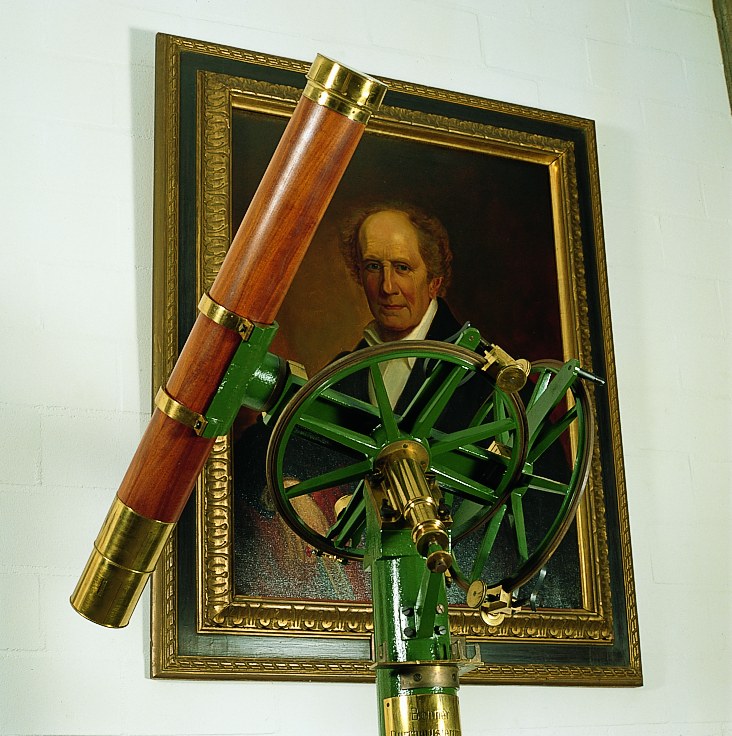The history of physics in Bonn
The development of physics and astronomy in Bonn began in the 19th century.

1989 Nobel Prize
Wolfgang Paul (1952–1981) worked in the fields of atomic, molecular and high-energy physics. He was awarded the Nobel Prize in Physics in 1989 for inventing the ion trap.
High-energy physics began in 1958 with the commissioning of a 500 MeV electron synchrotron, the first accelerator for producing mesons at a German university. Together with his colleagues Karl-Heinz Althoff (1965–1990), Gerhard Knop (1967–1988) and Gerhard Nöldeke (1967–1993), Wolfgang Paul then went on to build two more electron accelerators and expand research on an international scale.
Experimental physics
The story of experimental physics in Bonn begins with Julius Plücker (in Bonn 1836–1869), whose investigations into electrical discharge in gases laid the foundations for atomic and molecular spectroscopy (Geissler tubes).
Through his discovery of electromagnetic waves, Heinrich Hertz (1889–1894) opened the door to the world of information that we are familiar with today—the unit of frequency will forever be associated with his name. Bonn became one of the leading centers of spectroscopy thanks to Heinrich Kayser (1894–1920), whose successors Heinrich Konen (1920–1934) and Christian Füchtbauer (1935–1945) continued the research being done in this field.
Nuclear physics was given new impetus by Wolfgang Riezler (1962–1963) and his construction of a cyclotron. By converting it into an isochronous cyclotron, Erwin Bodenstedt (1962–1991) and Theo Mayer-Kuckuk (1965–1992) then forged new paths in the study of nuclear reactions and their application in nuclear solid-state physics.
Rudolf Jaeckel (1955–1963) conducted research into applied physics, producing findings on vacuum physics whose importance for modern research—with all its stringent requirements—cannot be overstated. His successor Siegfried Penselin (1963–1992) focused on the high-frequency spectroscopy of atoms and provided support at the Institute of Laser Physics.


Theoretical physics
Back in the 19th century, institutions did not distinguish between experimental and theoretical physics. Rudolf Clausius (1869–1888) was a pure theoretician. He researched the theory of heat phenomena, defined the second law of thermodynamics and coined the term “entropy,” which is now in common use well beyond the boundaries of physics. Heinrich Hertz’s theoretical study of the fields produced by the radiation of an oscillating dipole (an antenna) can now be found on every physics curriculum. While in Bonn, he also wrote a monograph on the foundations of theoretical mechanics that was regarded as extremely important at the time.
Walter Weizel (1936–1969) researched the quantum theory of molecular spectra and later the physics of gas discharge. Theoretical nuclear physics was established as a discipline by Konrad Bleuler (1960–1980), followed by theoretical elementary particle physics through the efforts of Horst Rollnik (1964–1996), Kurt Meetz (1967–1993), Klaus Dietz (1969–2000) and Werner Sandhas (1973–2000). The fields of theoretical research being explored have expanded considerably since then, with statistical mechanics, the relativistic quantum theory of atoms and condensed matter theory all being actively worked on by different groups.
Astronomy in Bonn
Astronomy in Bonn can be traced back to Friedrich Wilhelm Argelander (1836–1875), who established the observatory in 1845. Argelander became famous for the “Bonner Durchmusterung” (BD), a catalogue that records the exact positions and magnitudes of nearly 300,000 stars in the northern hemisphere and includes additional map material. Since then, stars have had names beginning with “BD.”
Karl-Friedrich Küstner (1891–1924) purchased a double refractometer, a refracting telescope 16.4 feet (5 meters) long that enabled the positions of the stars to be determined with a high level of precision. His aim was to study star clusters and the structure of the Milky Way.
Friedrich Eberhard Becker (1947–1966) founded a new observatory at “Hoher List” in the Eifel mountains in 1953, purchasing a new 3.2-foot (1 meter) reflector telescope to complement the existing ones. It was during this time that radio astronomy grew as a discipline and a telescope was set up on the “Stockert” mountain. The success of the discipline led to the establishment of the Max Planck Institute for Radio Astronomy, which operates the 100 m radio telescope on the Effelsberg.
Astronomers in Bonn use data from all parts of the electromagnetic spectrum: from radio waves and infrared, visible and ultraviolet light through to X-rays. Their research fields include stars and star clusters, galactic structures and galaxies, cosmology and interstellar and intergalactic matter.



